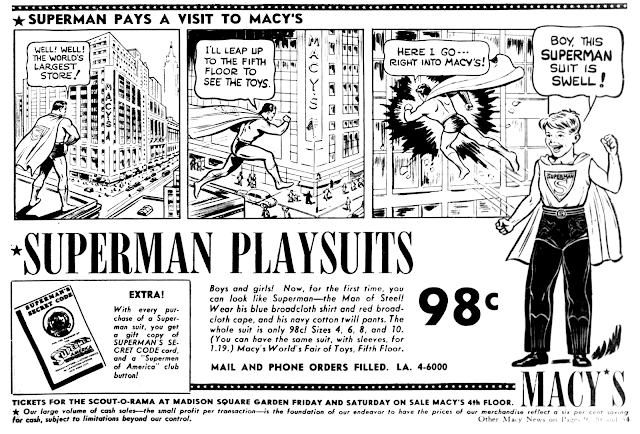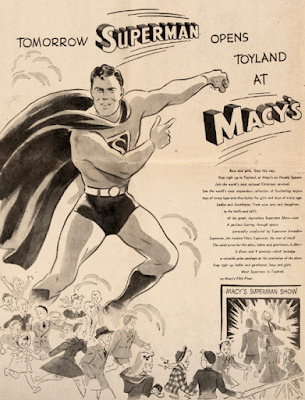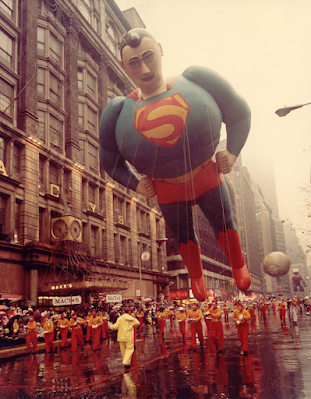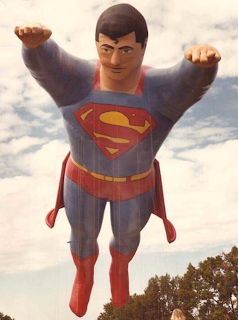Superman in the Macy's Thanksgiving Day Parade
A giant Superman balloon first appeared in the Macy's Thanksgiving Day Parade on November 21, 1940. The 17th annual parade began at 106 Street and
Central Park West at 11:45 AM. The route continued down Broadway to Macy's
flagship store on 34th Street around 1:30 PM. Various portions of the event were broadcast live on
local radio stations.
According to Macy's, the Superman balloon measured 75 feet in height, 44
feet in width, with a 30-foot cape. The towering figure held 9,000 cubic
feet of helium and required about 50 handlers. The balloon was designed by
renowned puppeteer and illustrator Tony Sarg. The neoprene rubber Superman was
constructed by The Goodyear Tire & Rubber Company at Plant One in Akron,
Ohio.
Somewhere along the parade route, the left foot was punctured and Superman
began to deflate. More helium was pumped in at 53rd and Broadway. The Superman
balloon was later refurbished as Hugo the Football Hero for the next parade
held on November 20, 1941. Hugo was scrapped in 1942, and the proceeds were
donated to the Red Cross War Fund.
-
R. H. Macy & Co. formed a partnership with Superman, Inc. in May 1940.
Macy's customers received a free
Supermen of America Club
membership kit with the purchase of a Superman Playsuit by A.S. Fishbach.
The Playsuit was later offered as a premium prize from
Superman Gum. On July 3, 1940, Macy's co-sponsored the "Superman Day" festivities at the New York World's Fair. The Thanksgiving parade
debut of Superman coincided with the opening of the "Superman Adventure"
at Macy's Toyland on November 16, 1940.
Semi-finalists from the
"Superman Day"
event were given two complimentary passes to the "Superman Adventure" at
Toyland. The live show was produced by R.A. Fine Promotions. Holiday
season attendance was approximately 100,000 visitors. A promotional image
for the "Superman Adventure" was painted by Lou Zimmerman. The design is
based on a "Superman Day" poster that was previously rejected by Superman,
Inc.
In 1940, cartoonist Russell Patterson illustrated "Alphabet on Parade"
designs for Macy's window displays. The series was published in Who's Who in Toyland, a poetry book written by Margaret Fishback. The S-float
depicts a character inspired by Superman.
A one-shot Superman's Christmas Adventure comic book
giveaway was distributed at Macy's and other retailers in December 1940.
The book contains an original 15-page story written by Jerry Siegel and
illustrated by Jack Burnley as Joe Shuster. The cover art was
provided by Fred Ray.
In August 1942, a partnership with Streeter Blair placed Superman in
department stores with the
Superman-Tim Club. Blair distributed the Superman-Tim magazine with advertisements
for boys clothing at regional retailers until 1950.
-
Superman returned for The 40th Annual Macy's Thanksgiving Day Parade on
November 24, 1966. The second Superman balloon was 65 feet tall, 33 feet
wide, and weighed 480 pounds. The 1966 balloon was constructed from 500
square yards of rubberized nylon and held 9,483 cubic feet of helium. The
project was supervised by William R. Ludwick and constructed by Goodyear
engineers in Rockmart, Georgia.
The 1966 parade began at 9:00 AM at 77th and Central Park West.
Strong winds blew the balloon into a tree and punctured the left arm. The
Superman balloon appeared for five years before being retired after November 26, 1970.
In 2005, the balloon was cut into swatches and given to Macy's employees
as souvenirs. The head is currently kept at the Macy's Parade Studio
in Moonachie, New Jersey.
-
A third Superman balloon first appeared at The 54th Annual Macy's
Thanksgiving Day Parade on November 27, 1980. The balloon was designed by
Sid Smith and constructed by Goodyear engineers in Rockmart, Georgia. The 104-foot long balloon was the largest parade balloon created by Goodyear, and third-largest in
the entire history of the parade. The 14 compartments
required an estimated $2,000 of helium. The balloon was accompanied by
bands performing the John Williams Superman March from Superman: The Movie.
On November 28, 1985, the left leg tore during preparation and Superman
did not appear in the parade. After returning on November 27, 1986, the
left hand was ripped off by a tree on Central Park West and the arm
completely deflated. The final appearance of the Superman balloon was on
November 26, 1987.
-
After gold was discovered in California, Rowland Hussey Macy and his
brother Charles left Massachusetts to seek their fortune. In July 1850,
the brothers established Macy & Co. on 2nd Street and Maiden Lane (Oak
Street) in Marysville. Macy's sold mining provisions, taking deposits in
gold dust and shipping the metal eastward. The partnership was
dissolved in September 1850, and Rowland
returned to Massachusetts. Charles remained in Marysville as a gold
banker, establishing Macy, Low & Co. in 1855.
In April 1851, Rowland partnered with his brother Robert in Haverhill,
Massachusetts. The R. B. Macy dry goods store was later known as Macy's
Haverhill Cheap Store. In November 1852, Rowland expanded the business
into Macy's Wholesale & Retail Dry Goods House at 70 Merrimack Street.
The first Macy’s holiday parade took place on July 4, 1854, in downtown
Haverhill. About 100 spectators gathered as a band marched past the store.
The Haverhill business closed the following year. On August 20, 1855,
Rowland H. Macy and E. F. Cushman were brought to Boston "on a charge of
defrauding sundry traders of this city out of $25,000 worth of goods by
false pretences [sic]."
On October 28, 1858, the R. H. Macy Dry Goods shop opened at 204–206 Sixth
Avenue in New York City. The first day sales amounted to $11.06. An
advertisement for a Christmas and New Year's sale was published in
December 1860, stating "Santa Claus will be prompt, as usual, therefore
there is no time to lose." The American tradition of a store Santa can be
traced back as early as 1841 in Philadelphia. Each year, Christmas
decorations and window displays at retail stores nationwide would become
more elaborate.
In 1862, Macy rebranded the business with a five-point red star based on
his arm tattoo. The store was expanded and reopened on September 25, 1872,
as R. H. Macy & Co.'s Grand Central Fancy Goods Establishment.
Following a new partnership in 1875, offices were opened in Paris and
Belfast. On March 29, 1877, Rowland H. Macy died of Bright's disease
while seeking medical treatment in Paris.
Each holiday season from 1882–1901, the storefront windows on Sixth Avenue
were decorated with elaborate mechanized scenes. The windows were unveiled each year
during the Holiday Opening event. The 1883 display featured a procession
of steam-powered dolls and circus animals. The early tableaux were
designed by the Lafayette W. Seavey Scenic Studio. The wax figures were
created by Alfred Alexander and artists from the Eden Musée.
In November 1902, the new flagship store opened uptown in Herald Square at
34th and Broadway. The moving window displays were absent from 1905–1922.
From 1923–1938, the windows featured animatronic marionette scenes
designed by puppeteer and illustrator Tony Sarg. Beginning in 1924, Sarg's
automatons were revealed in Herald Square at the terminus of Macy's annual
parade.
The tradition began as Macy's Christmas Parade, first held on Thanksgiving
Day, November 27, 1924. The first procession was comprised of over 1,000
Macy's employees marching with bands, circus performers, and animals from
Central Zoo. Horse-drawn floats were designed by Sarg based on nursery
rhymes that included the Old Lady in the Shoe, Little Red Riding
Hood, Little Miss Muffet, and the Three Men in a Tub.
The first parade departed at 9:00 AM from Convent and 145th Street in
Harlem, winding down Broadway to 34th. The original route was about six
miles and the column was two blocks in length. Around noon, an estimated
10,000 people gathered in Herald Square as Santa Claus was coronated "King
of the Kiddies." Santa sounded a trumpet to signal the unveiling of "The
Fairyfolk Frolics of Wondertown" window display. The crowd rushed past
police lines to view the animatronic Mother Goose characters. The 75-foot
display featured 26 different moving panoramic scenes and hundreds of
marionette figures.
The third Christmas Parade on November 25, 1926, was scheduled later
at 1:00 PM due to protests from the Allied Patriotic Societies about
religious interference. The 1926 pageant was designed and staged by Norman
Bel Geddes. The float themes included Punch and Judy, Cinderella's coach,
and a biplane of clowns. 1926 was the last year that featured animals from
Central Zoo.
The first giant helium balloons debuted at Macy's 5th Annual Christmas
Parade on November 29, 1928. The balloons were constructed by The Goodyear
Tire & Rubber Company in Akron, Ohio, based on designs by Tony Sarg
and his protégé Bil Baird. Five of the giant balloons were released during
the parade finale and Macy's offered a $100 prize for each one that was
returned.
The first balloons were designed to float at 2,000–3,000 feet for a week
and then slowly leak, but four of the balloons were recovered by the
following day. The 60-foot Sky Tiger was the first to land, causing a tug
of war in Richmond Hill, Queens. Some boys involved in the struggle
received a book of illustrations autographed by Sarg.
The first licensed character balloons appeared on November 28, 1929, with
the cast of The Katzenjammer Kids comic strip. The 40-foot
beard on the Herr Inspector balloon had to be trimmed en route to reduce
weight. Prizes for ten released balloons were reduced to $50 each.
On November 27, 1930, prizes for the retrieved balloons were reduced to
$25 each. The reward information was printed on a postcard enclosed inside
of a waterproof envelope. In a Thanksgiving radio address, Tony Sarg
advised Atlantic ships to be alert for the balloons. One was later
recovered about 110 miles away in Greenville, Connecticut.
Felix the Cat was the first animated cartoon character to appear as a
parade balloon, debuting in 1932. The original Felix the Cat balloon was
featured in the parade for two years before being retired after 1933.
Various news outlets and books have repeated an incorrect claim that Felix
the Cat was the first balloon in 1927. The giant balloons were not
introduced to the parade until 1928.
Reports also confuse Felix the Cat with two similar black cat balloons
that were released in 1931. One of the black cat balloons caught on fire
after floating into high-tension wires. The other was clipped by pilot
Clarence Chamberlin. Following the stunt, Macy's published warnings that
no prize money would be awarded to aviators.
The parade was first broadcast live on local radio by WOR at 3:30
PM on November 24, 1932. The 30-minute coverage was hosted by Roger
Bowers. Despite the new contest rules, a student pilot named Annette
Gibson steered a biplane into the 60-foot Tom Cat balloon. The balloon
caught the left wing, sending the plane into a tailspin over Queens.
Instructor Hugh Copeland regained control of the aircraft and landed
safely in Brooklyn. Macy's stopped releasing balloons for prizes after
1932.
The annual celebration was advertised as Macy's Santa Claus Parade
for November 29, 1934. A 40-foot Mickey Mouse, Pluto, and other Walt
Disney character balloons first appeared. The name was changed to Macy's
Thanksgiving Day Parade on November 28, 1935. The 1935 parade column was
about two miles long. Jim Willis made his first appearance as Santa Claus.
The Thanksgiving Day Parade was first televised in an experimental
broadcast by NBC on November 23, 1939. The shortwave video feed was
transmitted from above the American Museum of Natural History on W2XBS
from 12:00 PM to 1:00 PM. Tony Sarg and Russell Patterson were interviewed
during the telecast. Due to the technological limitations of the era, no
video recordings are known to exist.
No television broadcasts were produced in 1940 or 1941. Parade director
Tony Sarg passed away on March 7, 1942. The parade was suspended during
World War II from
1942 to 1944 due to helium and rubber shortages. About 650 pounds of
rubber scrapped from the balloons was donated to the war effort. Local
television coverage resumed when the parade returned on November 22, 1945.
Scenes from Miracle on 34th Street were filmed on
location during the parade on November 28, 1946. The movie was released on
June 11, 1947, drawing nationwide attention to Macy's annual event. Harry
Antrim portrayed a fictional version of R. H. Macy.
The parade was first nationally televised by CBS on November 25, 1948.
Since 1953, NBC has been licensed as the official broadcaster. NBC first
aired the parade in color on November 26, 1964. Only two complete telecast
recordings exist before 1980: 1959 and 1976. CBS has continued to air
coverage as The Thanksgiving Day Parade on CBS.
The 1966 parade was stopped multiple times for commercial breaks and other
time delays. The New York Times reported "many of the marching
units seemed to save themselves for their brief appearance before the
cameras, which were set up in Herald Square." The window display unveiling
gradually became overshadowed by the television productions.
In 1981, Kemp Balloons, Inc. of Maryland replaced Goodyear as the balloon
manufacturer. From 1984–2019, the balloons were constructed by Raven
Aerostar.
The wind is always a concern for handlers and many balloons have been
damaged by the trees of Central Park West. In 1971, heavy rain and wind
gusts up to 40 miles per hour caused the balloons to be removed from the
parade for safety concerns. In 1993, high winds sent a 64-foot Sonic the
Hedgehog balloon into a lamp post, injuring two people. In 1997, a Cat in
the Hat balloon crashed into a street light, leaving one woman in a 22-day
coma. After the incident, balloons over 70 feet in height, or 78 feet in
length, were banned from the event. In 2005, a 40-foot M&M balloon was
grounded after injuring two spectators.
-
"100,000 Children See Store Pageant." The New York Times, 30 November 1928, p. 48.
"Alters Macy Parade Plan." The New York Times, 23 November 1926, p. 19.
"At Sea; Ocean Watch Asked by Macy's for Only Balloon Animal Still at Large After Parade." The New York Times, 2 December 1931, p. 2.
"Balloons Unruly in Store's Parade." The New York Times, 29 November 1929, p. 16.
Bracker, Milton. "'Superman' Day is Held." The New York Times, 4 July 1940, p. 13.
"Christmas Parade Staged in Broadway." The New York Times, 25 November 1927, p. 13.
Daley, Suzanne. "Cheers Mixed With Shivers Greet Parade." The New York Times, 26 November 1982, pp. A1, B2.
"Felix the Cat Soars Gayly in Broadway." The New York Times, 27 November 1931, p. 23.
"Fliers Hit Balloon, Plunge 5,000 Feet." The New York Times, 25 November 1932, pp. 1, 5.
"Four Macy Balloons Land." The New York Times, 1 December 1928, p. 31.
"Giant Heroes of Parade Thrill 1,000,000 Watchers." Brooklyn Daily Eagle, 22 November 1940, p. 7.
Gill, Brendan. "Home for Christmas." The New Yorker, 21 November
1953, p. 38.
"Greet Santa Claus as 'King of Kiddies'." The New York Times, 28
November 1924, p. 15.
Hartford Courant, 21 August 1855, p. 2.
"Lady Bountiful now on Exhibition." The Evening World, 24 November 1903, p. 4.
"Macy Parade Televised." Broadcasting, 1 December 1939, p. 65.
"Macy Parade Wins Old-Time Acclaim." The New York Times, 23 November 1945, p. 34.
"Macy's Christmas Parade Big Thanksgiving Day Feature." The Daily Home News, 26 November 1924, p. 9.
"Now for Christmas." The Evening World, 20 November 1894, p. 3.
Hartford Courant, 21 August 1855, p. 2.
"Lady Bountiful now on Exhibition." The Evening World, 24 November 1903, p. 4.
"Macy Parade Televised." Broadcasting, 1 December 1939, p. 65.
"Macy Parade Wins Old-Time Acclaim." The New York Times, 23 November 1945, p. 34.
"Macy's Christmas Parade Big Thanksgiving Day Feature." The Daily Home News, 26 November 1924, p. 9.
"Now for Christmas." The Evening World, 20 November 1894, p. 3.
"Odd Rubber Folk Stage Gay Parade." The New York Times, 24 November
1939, p. 19.
"Out of Control." Eyewitness News. WABC-TV, 26 November 1997.
Phelps, Timothy M. "Parade Matches Heights of Tradition." The New York Times, 28 November 1980, p. B2.
Printer's Ink, 21 December 1892, p. 840.
Ravo, Nick. "A Happy Day of Heroes and Feasts." The New York Times, 28 November 1986, pp. B1, B7.
Reeves, Richard. "Parade To Draw 2 Million Today." The New York Times, 24 November 1966, p. 79.
"R. H. Macy & Co." The New York Times, 23 November 1885, p. 8.
"Rubber Giants Aid Fund." The New York Times, 25 November 1942, p. 21.
"Out of Control." Eyewitness News. WABC-TV, 26 November 1997.
Phelps, Timothy M. "Parade Matches Heights of Tradition." The New York Times, 28 November 1980, p. B2.
Printer's Ink, 21 December 1892, p. 840.
Ravo, Nick. "A Happy Day of Heroes and Feasts." The New York Times, 28 November 1986, pp. B1, B7.
Reeves, Richard. "Parade To Draw 2 Million Today." The New York Times, 24 November 1966, p. 79.
"R. H. Macy & Co." The New York Times, 23 November 1885, p. 8.
"Rubber Giants Aid Fund." The New York Times, 25 November 1942, p. 21.
"Santa Brings Snow for Macy's Parade." The New York Times, 28
November 1930, p. 4.
"Santa Claus Appears in Christmas Parade." The New York Times,
27 November 1925, p. 2.
"Santa Claus in a Window." The Argus, 3 December 1899, p. 7.
"Santa Claus in a Window." The Argus, 3 December 1899, p. 7.
"Santa Still No. 1 to Small Fry Among Throng at Toyland Parade." The New York Times, 21 November 1941, p. 12.
"See Macy's Stupendous Thanksgiving Parade!" Daily News, 20 November 1940, p. 5.
Smith, Terrence. "Contrasts Mark Thanksgiving Day." The New York Times, 25 November 1966, pp. 1, 41.
"Store to Present Holiday Pageant." The New York Times, 27 November 1928, p. 20.
"Superman Pays a Visit to Macy's." Daily News, May 16, 1940, p. 21.
"Superman Struts in Macy Parade.” The New York Times, 22 November 1940, p. 18.
"Today on Radio." The New York Times, 30 November 1933, p. 40.
"Their 36th Holiday Opening." The Evening World, 21 November 1893, p. 2.
"Toy Cat Expires in Blaze." The New York Times, 3 December 1931, p. 2.
"Wind Worries." Eyewitness News. WABC-TV, 25 November 1993.
Zimmerman, Lou, artist. "Tomorrow Superman Opens Toyland at Macy's." The New York Sun, 15 November 1940, p. 14.
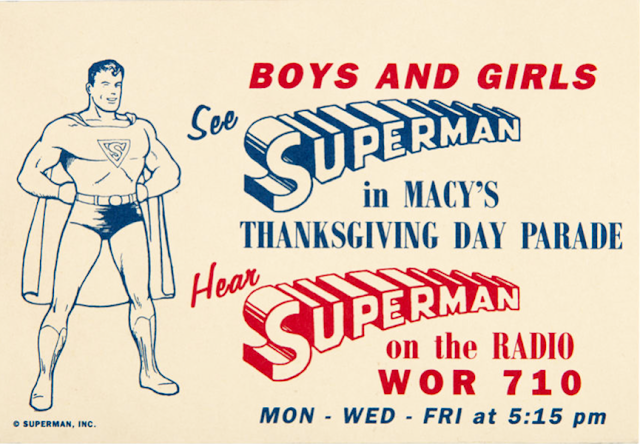


.png)
.png)
,%20Macy)
